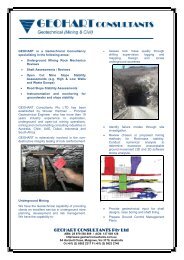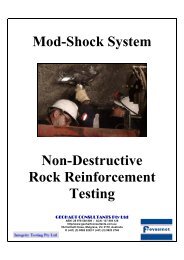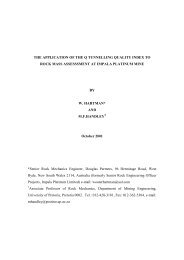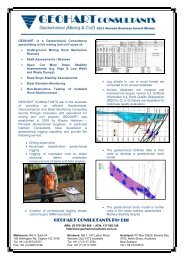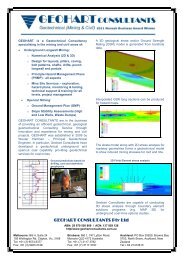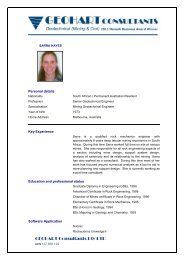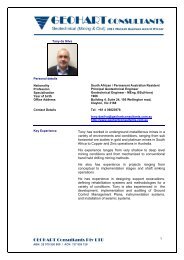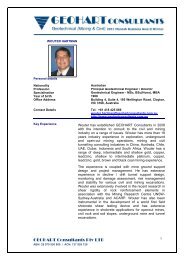Managing Geotechnical Risk through Non-Destructive Rock ...
Managing Geotechnical Risk through Non-Destructive Rock ...
Managing Geotechnical Risk through Non-Destructive Rock ...
Create successful ePaper yourself
Turn your PDF publications into a flip-book with our unique Google optimized e-Paper software.
Second Ground Control in Mining Conference 2010<br />
<strong>Managing</strong> <strong>Geotechnical</strong> <strong>Risk</strong> <strong>through</strong> <strong>Non</strong>-<strong>Destructive</strong> <strong>Rock</strong><br />
Reinforcement Testing Trialled at the George Fisher Mine, Mt.<br />
Isa.<br />
W Hartman, F Harvey, B Lecinq, J Higgs and D Tongue<br />
Contact Author: (Use “Author Details” style)<br />
Full name<br />
Wouter Hartman<br />
Position title<br />
Principal <strong>Geotechnical</strong> Engineer / Director<br />
Organisation Name Geohart Consultants Pty Ltd<br />
Address<br />
5a Hartnett Close, Mulgrave, 3170, Victoria<br />
Phone +61 (3) 8562 2217<br />
Fax +61 (3) 9923 2746<br />
Mobile +61 418425069<br />
Email<br />
wouter.hartman@geohartconsultants.com.au<br />
1
<strong>Managing</strong> <strong>Geotechnical</strong> <strong>Risk</strong> <strong>through</strong> <strong>Non</strong>-<strong>Destructive</strong> <strong>Rock</strong><br />
Reinforcement Testing Trialled at the George Fisher Mine, Mt.<br />
Isa.<br />
W Hartman 1 , F Harvey 2 , B Lecinq 3 , J Higgs 4 and D Tongue 5<br />
1.<br />
Name<br />
Position title<br />
Organisation Name<br />
Address<br />
Email<br />
Wouter Hartman<br />
Principal <strong>Geotechnical</strong> Engineer / Director<br />
Geohart Consultants Pty Ltd<br />
5a Hartnett Close, Mulgrave, 3170, Victoria<br />
wouter.hartman@geohartconsultants.com.au<br />
2.<br />
Name<br />
Position title<br />
Organisation Name<br />
Address<br />
Email<br />
Fred Harvey<br />
<strong>Rock</strong> Mechanics Superintendent<br />
XSTRATA, George Fisher Zinc Mine<br />
Mt. Isa, QLD<br />
fharvey@xstratazinc.com.au<br />
3.<br />
Name<br />
Benoit Lecinq<br />
Position title<br />
<strong>Managing</strong> Director<br />
Organisation Name Freyssinet Australia Pty Ltd<br />
Address Level 3, 13-15 Lyonpark Road Macquarie Park NSW 2113<br />
Email<br />
blecinq@freyssinet.com.au<br />
4.<br />
Name<br />
John Higgs<br />
Position title<br />
Director<br />
Organisation Name Integrity Testing Pty Ltd<br />
Address PO BOX 1299, Bendigo, Vic 3552<br />
Email<br />
jshiggs@integritytesting.com.au<br />
5.<br />
Name<br />
David Tongue<br />
Position title<br />
Director<br />
Organisation Name Integrity Testing Pty Ltd<br />
Address PO BOX 1299, Bendigo, Vic 3552<br />
Email<br />
djtongue@integritytesting.com.au<br />
2
ABSTRACT<br />
Corrosion affects the performance of rock support and reinforcement at various underground mines,<br />
including the George Fisher Mine, where recent studies showed that this risk to mining operations<br />
is generally not well understood. Corrosion reduces the capacity and life expectancy of ground<br />
support and generally is undetected unless the traditional destructive pull out test is employed to<br />
detect defect bolts. Where it is still acknowledged that the pull out test has still an important role to<br />
play in determining critical bond lengths for static and quasi static ground support designs, it does<br />
not provide an underground operation with any reassurance regarding its bolt‟s integrity, which has<br />
been compromised by in-situ aggressive conditions. <strong>Non</strong>-destructive rock reinforcement calibration<br />
testing on single and twin strand cable bolts, rebar bolts and friction bolts at the George Fisher Mine<br />
enabled the testing team to detect bolts with compromised integrity in one area of the mine. The<br />
non-destructive rock reinforcement integrity testing conducted uses a complex “Stress Wave<br />
Analysis“ package based on the processing of clear seismic signals imparted into the rock<br />
reinforcement element that is being tested. The seismic signals are processed by “Fourier<br />
Transform” into various criteria which can be used to produce models of the element such as<br />
mechanical admittance, frequency spectra and velocity which are all being used in the final<br />
modelling of the rock reinforcement element under analysis. This paper highlights the enormous<br />
potential to effectively manage the geotechnical risk that corrosion presents for an underground<br />
mining operation.<br />
INTRODUCTION<br />
It has been found <strong>through</strong> previous studies that corrosion reduces the capacity and life expectancy<br />
of ground support (Villaescusa, Hassle and Thompson, 2007) and generally is undetected unless the<br />
traditional destructive pull out test (see Figure 1) is employed to detect defect bolts.<br />
If the ground support elements do not fail after employing the pull testing device the uncertainty in<br />
regard the ground support system integrity remain. It was also apparent that the hydraulic pull<br />
testing device cannot provide a good indication of the effectiveness of the fully grouted bolt<br />
following a recent review of non-destructive testing (Buys, 2008). It is however acknowledged that<br />
the pull out test has still an important role to play in determining critical bond lengths for static and<br />
quasi static ground support designs but does not provide an underground operation with any<br />
reassurance regarding its bolt‟s integrity, which could have been compromised by in-situ aggressive<br />
conditions. Thus in order to determine whether ground support elements have been compromised<br />
3
<strong>through</strong> corrosion an operation would need to undergo destructive over coring of their rock<br />
reinforcement system. Not only is it an extremely time consuming exercise but quite expensive too.<br />
The George Fisher Mine, which is located 20km north of Mt. Isa and over 950 km west of<br />
Townsville in North Queensland (See Figure 2), embarked on a program of <strong>Non</strong>-<strong>Destructive</strong> rock<br />
reinforcement calibration testing on single and twin strand cable bolts, rebar bolts and friction bolts<br />
which enabled the testing team to detect bolts with compromised integrity in one area of the mine.<br />
This testing program highlighted the enormous potential to effectively manage the geotechnical risk<br />
that corrosion presents for underground mining operations.<br />
BACKGROUND TO NON-DESTRUCTIVE TESTING<br />
Investigations into premature rock bolt failures in the Australian Coal Mining industry identified the<br />
problem in 9 different collieries <strong>through</strong>out NSW and Queensland. Samples of broken bolts have<br />
been collected from at least 5 of these mines for detailed metallurgical testing. Because of the<br />
sporadic occurrence of premature bolt failure and the low level of record keeping within the mines,<br />
only a limited sample was available for the investigator‟s database. The investigation also<br />
highlighted that only bolts which have fallen to the ground are normally recognised as premature<br />
failures and to date there has been no method of identifying broken bolts which have failed within<br />
the encapsulated portion of the bolt or are restrained in the roof by strata shear. The investigation<br />
recognised from the outset that the database obtained from broken bolts found on the floor of mine<br />
roadways may only be a small part of the problem. The type of failures being identified could just<br />
as easily be occurring within the grouted horizon. This would leave partially or totally failed bolts<br />
grouted into the roof, providing the potential for an extremely hazardous situation of roof instability<br />
developing, with little or no warning to operators. It was recognised that there was a need for a nondestructive<br />
device to be available to the industry to be able to check bolt integrity on a routine basis<br />
(Hebblewhite, Fabjanczyk and Gray, 2003).<br />
Buys (2008) found that studies to develop non-destructive testing methods to determine a rock<br />
bolt‟s integrity have been conducted since 1977. He further critically reviewed current developed<br />
systems and highlighted their respective limitations.<br />
4
(i)<br />
Boltometer<br />
Instrument can be used on cemented grouted bolts and also on polyester and some other<br />
grouts. Buys found that the Boltometer can indicate bad ground, but if the impedance<br />
between the grout and surrounding rock are the same; wave energy will dissipate into the<br />
rock before it could reach a major defect, reporting good grouting.<br />
(ii)<br />
JK rockbolt tester<br />
Device developed by the JKMRC at the University of Queensland and is based on the<br />
measurement and analysis of the complete dynamic response of the bolt. The essence of<br />
the method is to measure the frequency response function of the bolt. This function can<br />
be considered as the signature of the bolt in situ. Resonant frequencies and associated<br />
damping ratios are primarily determined by the mechanical characteristics of the bolt in<br />
situ, resin grout and the rock.<br />
(iii)<br />
GRANIT<br />
The ground anchorage integrity testing (GRANIT) system was developed at the<br />
University of Aberdeen in Scotland. This testing system applies an impulse of known<br />
force by means of an impact device that is attached to the tendons. The vibration signals<br />
that arise from this impulse are complex in nature and require analysis to be performed.<br />
Novel artificial intelligence techniques are used in order to learn the complicated<br />
relationships that exist between anchorage and its response to an impulse. A single axial<br />
impulse load is generated at the head of the tendon. A set of datum responses signatures<br />
for different post-tension levels is recorded for the anchorage immediately after<br />
installation. The condition of the tendon at any later date can be determined by<br />
comparing the datum with the characteristics of the subsequent response signatures. A<br />
change in characteristics indicates a potential change in the integrity of the anchorage. It<br />
is difficult determining the relationship between the dynamic response of the anchorage<br />
and its post tension level. Therefore, neural networks are implemented, which suit the<br />
task of learning such complicated non-linear relationships. The neural network, trained<br />
on a single tendon, may be used to diagnose the post tension level of a number of<br />
tendons. The disadvantage of this system is that it can only work on rock bolts that have<br />
been charaterised at installation.<br />
5
(iv)<br />
Ultrasonic Guide Wave Testing<br />
A technique developed by Imperial College in England and it‟s based on an ultrasonic<br />
pulse echo test carried out from the free end of the bolt. Beard and Lowe (2003) showed<br />
that the approach could determine the bolt length and identify major defects such as loss<br />
of resin encapsulation, necking and deformation. A short duration Gaussian windowed<br />
sine burst is used to excite a guide wave in the bolt, which is then reflected from the bolt<br />
end and from any major defects. The reason for using a Gaussian windowed sine burst<br />
signal is that the excitation frequency can be tightly controlled and thereby excites<br />
specific modes. From the reflection arrival time and knowledge of the wave velocity<br />
dispersion curves the positions of the defects or the bolt length can be calculated. The<br />
maximum test range is limited by the amount of attenuation that the wave experiences as<br />
it propagates. The major cause of attenuation is the fact that ultrasonic energy tends to<br />
leak from the bolt into the surrounding rock. The study concluded that bolts should be<br />
tested in its low frequency range (30-70 kHz) as well as in its high frequency range (2-5<br />
MHz). The low frequency test can be used to identify defects such as partial bolt<br />
encapsulation and possibly corrosion patches near the bolt surface. The high frequency<br />
test is not sensitive to surface defects, but can give a reliable indication of the bolt<br />
length. It was not possible with their modeling tools to determine the dispersion<br />
relationships for bars with 3 dimensional features, as the rock bolt end and certain<br />
defects are not always axial symmetric it may be neccesary to model the bolt with threedimensional<br />
finite element methods.<br />
The MODSHOCK system used within the testing program at the George Fischer mine compared to<br />
the above methods is relatively simple in operation. In simple terms, the modified shock test as<br />
described by Higgs and Tongue (1999) is a seismic test using a hammer blow as the force and a<br />
transducer to pick up the resultant vibrations With the application of digital filtering techniques an<br />
accurate mechanical admittance vs. frequency plot is obtained which can then be interpreted using<br />
the concepts developed by Davis & Dunn (1974).<br />
This non-destructive method by vibration has its origins from Davis and Dunn where they carried<br />
out various types of non-destructive pile tests on sites in Western Europe and other French speaking<br />
countries for “The Centre Experimental de Recherches et d’Etudes du Batiment et des Travaux<br />
Publics” (CEBTP) of France. This vibration method had also been used and described by Gardner<br />
and Moses (1973), but this technique had not been exploited by British engineers to the extent that<br />
6
could have been useful to them because of a lack of knowledge of the technique and a degree of<br />
mysticism associated with the interpretation of the results.<br />
Since vibration testing of piles was first started by the CEBTP a considerable amount of theoretical<br />
work had been done which shed light on interpretation, and the experience of testing many<br />
thousands of piles led to the technique being applied with more confidence to piles on sites which<br />
lend themselves to being tested in this way. The main function of the test was to detect any major<br />
defect such as an open fracture or an important strangulation of the concrete, particularly in the<br />
upper portion of the pile.<br />
The method is based on measuring the frequency and amplitude response of a rock reinforcement<br />
element known as impulse. This response, known as Mechanical Admittance (or mobility), contains<br />
all the information necessary to confirm rock reinforcement integrity and to analyse the surrounding<br />
influences. At higher frequencies the resonating harmonics of the rock reinforcement element are<br />
detected, whereas at low frequency the response is generally linear allowing measurement of the<br />
element-head stiffness.<br />
The non-destructive rock reinforcement integrity testing analysis is conducted using a complex<br />
“Stress Wave Analysis“ package based on the processing of clear seismic signals imparted into the<br />
rock reinforcement element that is being tested. The seismic signals are processed by “Fourier<br />
Transform” into various criteria which can be used to produce models of the element such as<br />
mechanical admittance, frequency spectra and velocity which are all being used in the final<br />
modelling of the rock reinforcement element under analysis.<br />
In research and laboratory applications of modal analysis, particularly of complex machinery,<br />
dynamic excitation was often provided by a linear hydraulic or eccentric mass shaker. Experience<br />
gained in testing over 140 bridges indicated that simpler means of excitation are suitable for 90% of<br />
all bridges where attaching shakers to bridges were seen as a complex and costly method and is<br />
only practical for research purposes or for extremely complex structures [4]. Similarly the<br />
application for rock reinforcement integrity testing it was found that a simpler method to excite<br />
bolts is adequate for the detection of defects.<br />
The development of the Australian based testing method started in the late 80‟s and has been used<br />
for the correct assessment on a large variety of elements, which now exceeds well over 1,000,000<br />
7
tests for more than 20 years [5]. Integrity Testing PTY LTD (i.e. developers of the Modshock<br />
system) has for over 15 years carried out testing of long length steel rods, either as strand or solid<br />
steel bars. The most notable project was for BHP, when they owned the Whyalla steel works where<br />
they tested the tie rods holding back the crucial steel pile wall of the coal handling jetty.<br />
The rods were tested and not only were the defective rods identified but it was indicated at what<br />
point the rods had lost a large cross section. This was located at a point where the rods came close<br />
to the base of the coal handling pit and water was seeping onto the rods causing corrosion. Thus a<br />
large successful background in the testing of steel embedded elements, generally with the lengths in<br />
excess of 5 meters.<br />
CALIBRATION TESTING PROGRAM AT GEORGE FISHER MINE<br />
The bolts tested at George Fisher Lead-Zinc Mine consisted of:<br />
i) Cable Bolts<br />
ii)<br />
iii)<br />
Resin Bolts and<br />
Friction Stabiliser Bolts.<br />
i) Cable Bolts (Figure 3 – Table 1)<br />
The cable bolts tested were:<br />
<br />
<br />
6m and 8m Single Strand Cable Bolts – One bulb per meter.<br />
6m and 8m Twin Strand Cable Bolts - One bulb per meter.<br />
ii) Resin Bolts (Figure 4 and Table 2)<br />
The resin bolts tested were:<br />
2.2m Thread Bar Posimix.<br />
8
iii) Friction Bolts (Figure 5 and Table 3)<br />
The friction bolts tested were:<br />
2.4m Friction Bolt, 47mm diameter.<br />
Test Site Locations<br />
The site testing was conducted on the 8 th September 2009 and 16 th October 2009. The following<br />
sites were selected by Mr. Fred Harvey (<strong>Rock</strong> Mechanics Superintendent):<br />
6 Level 5053 EXC – Calibration Tests for Cable Bolts, Resin bolts and Friction<br />
Bolts.<br />
16 Level – Tests for grouted and resin solid bars (Test results not part of this<br />
paper).<br />
6 Level 5053 East Crosscut Calibration Tests Set-up<br />
Table 4 and Figure 6 provide information regarding the Single Strand Cable bolt<br />
calibration set-up.<br />
Table 5 and Figure 7 provide information regarding the Twin Strand Cable bolt calibration<br />
set-up.<br />
Table 6 and Figure 8 provide information regarding the Resin Bolt calibration set-up.<br />
Table 7 and Figure 9 provide information regarding the Friction (Splitset) Bolts calibration<br />
set-up.<br />
9
16 Level Tests<br />
Four tests areas were selected:<br />
Test Area 1 - Northern shaft bypass excavation<br />
Test Area 2 - Old Crib Room<br />
Test Area 3 – Opposite Sub Station<br />
Test Area 4 – Opposite temporary crib room<br />
16 Level were chosen in particular as the area is subject to very aggressive corrosive conditions.<br />
Test Area 2 (Old Crib Room) rock bolts exhibits a high level of corrosion and evidence of this was<br />
found in a rock bolt that dislodged from the backs (see Figure 10 - corroded rockbolt).<br />
TESTS<br />
A total of 56 bolts were tested between the 8 th September and 16 th October 2009 (19 bolts on the 8 th<br />
September ‟09 and 37 bolts on the 16 th October „09). The data obtained were transferred from the<br />
field Notebook PC of the Mod-Shock System and analysed with the IntegxD7 Programme (Integrity<br />
Testing Pty Ltd). Slight modifications (i.e. Graph presentation) to the programme‟s output graphs<br />
were made during the analysis process. These changes were necessary to provide George Fisher<br />
Lead-Zinc Mine with clear results.<br />
TEST RESULTS AND DISCUSSIONS<br />
Calibration Bolts – 6 Level 5053<br />
Single Strand Cable Bolts<br />
During our investigation (calibration testing) on the cable bolts we noticed an interesting<br />
phenomenon in the 2D mechanical admittance plot for the cable bolts which were previously<br />
noticed when testing cable bolts at another mine. This relates to the first part of the mechanical<br />
admittance plot (see below Figure 11 – Single Strand Cable Bolt Test No.4).<br />
The two opposing curved black lines on the graph represent structural stiffness <strong>through</strong> good<br />
embedment or load transfer. The top (blue) and bottom (green) horizontal lines in the graph<br />
collectively represent the element‟s full diameter. The structural stiffness presented in the two<br />
dimensional plot together with the element‟s diameter are used to indicate whether any disturbance<br />
10
(i.e. bolt necking, bolt volume reduction <strong>through</strong> corrosion, bolt shearing (Hartman, 2003) and/or<br />
ineffective grout or resin embedment) or reflection point can be detected during testing.<br />
Figure 11 above shows some similarity to the load vs dissipation rate graph of a fairly recent (2004)<br />
collaborative investigation into the behaviour of cable bolts between the University of<br />
Saskatchewan, Saskatoon; Itasca Consulting Group, Inc., Minneapolis; University of British<br />
Columbia, Vancouver (BC) and the US National Institute of Safety and Health (NIOSH), which<br />
provided valuable information regarding their loading and strain behaviour.<br />
An article by Martin et al (2004) showed that a critical load is required before the cable bolt, at a<br />
given location, sense any load. This was done <strong>through</strong> instrumented cable bolts loaded at the collar<br />
and plotted against recorded microstrain at individual gauge locations (see below in Figure 12 the<br />
load profile along the length of the cable at different collar loads). This implied that a gauge<br />
positioned 25.4 cm from the collar will sense load only when the collar load exceeds 25.4 × 2,043<br />
N/cm.<br />
The above phenomenon however would need to be confirmed with some instrumented bolts.<br />
The test results obtained from the calibration tests are provided in Table 8 below and discussed<br />
further.<br />
One of the vital pieces of information obtained from the non-destructive test is the “Head Stiffness”<br />
as this is the basis of all the load predictions and it also indicates the serviceability of the total bolt<br />
system. The head stiffness is the “E” prime of the bolt, measured as a direct measurement of the<br />
first part of the “structural stiffness plot”, and is similar to a load/displacement graph for a pull out<br />
test.<br />
The “bolt head stiffness (tonnes/mm)” is compared to the two model stiffness values “E” min and<br />
“E” max. “E” min is a bolt model with the bolt pinned at its toe (end anchored) but with no<br />
clamping (no resin or grouting) along its length. “E” max is a bolt model with an infinite rigid base<br />
and “clamped” (full column grouted / resin) along its length. These models are based on the work<br />
carried out by Davis & Dunn (1974).<br />
The “Stiffness” value of the bolt is a good indicator of the serviceability of the bolt, but cannot be<br />
used in its entirety to give a serviceability rating for the bolt, as a number of factors come into affect<br />
when measuring the stiffness. The measurement of the stiffness can be affected by the fixity of the<br />
end of the bolt, the bonding effect of the resin/grout around the bolt and the bond from the rock to<br />
the resin/grout to ensure a fully encapsulated scenario of the bolt.<br />
11
The following comments were made regarding the calibration tests for the single strand cable tests<br />
data interpretation:<br />
Tests 4 and 8 were done on the same bolt. The test results showed that the grouting<br />
of the toe and collar with a centre free length was clearly detected using the<br />
Modshock system. The anticipated grout location of 1.5m away from the toe and<br />
collar could not be accurately picked as the location of the grout appears to be<br />
slightly different that what has been proposed. This could very well be a sign of the<br />
lack of control during the grout installation.<br />
Test 3 results showed that the grouting of the toe (1.9m) and free length towards the<br />
collar was clearly detected using the Modshock system. The 6.0m long cable had a<br />
0.692m tail and 5.31m length inside the hole. The anticipated grout embedment<br />
length of 1.9m has been detected (i.e. an area of load transfer) and appear to be<br />
located at 3.6m to 5.5m. The test result also suggests a gap towards the end of the<br />
hole (see Figure 13).<br />
Test 51 showed that the grout location appear to be between 2.7m and 4.4m an<br />
embedment length of 1.7m and not the anticipated 1.3m grouted length. The cable<br />
bolt had a tail length 0.402m and 5.598m length inside the 6.2m long hole. This<br />
would be one of the cable bolts required to be checked for correct embedment length.<br />
Test No 34 showed that the grouting of the cable bolt toe (0.9m) and free length<br />
towards the collar was clearly detected using the Modshock system. The 8.0m long<br />
cable had a 0.402m tail and 7.42m length inside the hole. The anticipated grout<br />
embedment length of 0.9m has been detected (i.e. an area of load transfer) and<br />
appear to be located at 6.35m to 7.35m. The test result also suggests a gap towards<br />
the end of the hole (see Figure 14).<br />
Test No 57 – Very poor signal – Test discarded.<br />
Test No 15 showed that the grouting of the cable bolt toe (2.95m) and free length<br />
towards the collar was clearly detected using the Modshock system. The 6.0m long<br />
cable had a 0.500m tail and 5.5m length inside the hole. The anticipated grout<br />
embedment length of 2.95m has been detected (i.e. an area of load transfer) and<br />
appear to be located at 3.4m to 5.85m. The test result also suggests a gap towards the<br />
end of the hole.<br />
12
Test No 13 and 9 showed that full column grouting of the hole did not occur as load<br />
transfer for both tests appear to be towards the latter part of the hole and a gap<br />
towards the earlier parts of the hole.<br />
Twin Strand Cable Bolts<br />
The test results obtained from the calibration tests are discussed below. A summary of the test<br />
results are provided below in Table 9.<br />
The following comments are made regarding the calibration tests for the twin strand cable tests data<br />
interpretation:<br />
Tests 1 results showed that the grouting of the toe and collar with a centre free length<br />
was clearly detected using the Modshock system. The anticipated grout location of<br />
1.5m away from the toe and collar could not be accurately picked as the location of<br />
the grout appears to be slightly different that what has been proposed. The toe area<br />
only shows a 0.7m area embedment length with bolt end at 6.0m.<br />
Test 2 results showed that the grouting of the toe and free length towards the collar<br />
was clearly detected using the Modshock system. The 6.0m long cable had a 0.550m<br />
tail and 5.45m length inside the hole. The anticipated grout embedment length of<br />
1.5m appears to cover a much larger area (i.e. 2.0m – 2.4 to 4.4m) than what was<br />
proposed (i.e. an area of load transfer). The test result also suggests a gap towards the<br />
end of the hole (see Figure 15).<br />
Test 41 results showed that the grouting towards the toe of the hole was clearly<br />
detected using the Modshock system. The 6.0m long cable had a 0.580m tail and<br />
5.42m length inside the hole. The anticipated grout embedment length of 1.5m<br />
appears to covers a slightly larger area (i.e. 3.0m – 4.7m) than what was proposed<br />
(i.e. an area of load transfer). The test result also suggests a gap towards the end of<br />
the hole (See Figure 16).<br />
Test 52 results clearly shows the end of the bolt at 7.7m, but indicates that the<br />
grouting towards the toe of the hole only covered about 1m (i.e. between 6-7m). The<br />
8.0m long cable had a 0.30m tail and 7.7m length inside the hole. The anticipated<br />
grout embedment length of 1.5m appears to covers a slightly smaller area (i.e. 6.0m –<br />
7.0m) than what was proposed (i.e. an area of load transfer). The test result also<br />
suggests a gap towards the end of the hole.<br />
13
A test 58 result does not clearly show the end of the bolt at 7.36m and indicates that<br />
the grouting towards the toe of the hole covers about 1m (i.e. between 6.5-7.36m).<br />
The 8.0m long cable had a 0.640m tail and 7.36m length inside the hole. The<br />
anticipated grout embedment length of 3.0m appears to cover only a smaller area (i.e.<br />
6.5m – 7.36m) than what was proposed (i.e. an area of load transfer). The test results<br />
indicate that grouting was done for a 1.7m distance to the back of the hole (i.e.<br />
8.2m). The result also suggests remnant grout lower down the hole as an area of high<br />
load transfer is shown.<br />
A test 62 result does not clearly show the proposed end of the bolt at 5.7m. The<br />
results indicate that the grouting towards the toe of the hole covers about 1m (i.e.<br />
between 5.2m – 6.2m). The 6.0m long cable had a 0.30m tail and 5.7m length inside<br />
the hole. The anticipated grout embedment length of 3.0m appears to cover only a<br />
smaller area (i.e. 5.2m – 6.2m) than what was proposed (i.e. an area of load transfer).<br />
The result, similar to the previous test 58m, suggests remnant grout lower down the<br />
hole as an area of high load transfer is shown.<br />
Test 21 results clearly shows a full column grouted bolt with only one major<br />
reflection point within in the total length at 1.25m. The 2D mechanical admittance<br />
plot clearly indicates a full column grouted bolt with also similar stress / strain<br />
patterns closer to the collar of the hole. When testing cable bolts this is typical what<br />
the signature should show.<br />
Resin Bolts<br />
The test results obtained from the calibration tests are discussed below. A summary of the test<br />
results are provided below in Table 10.<br />
The following comments are made regarding the calibration tests for the resin bolt tests data<br />
interpretation:<br />
Test 27 was a shorter bolt installed by George Fisher and following a detailed<br />
analysis of the bolt signal and admittance plot it shows clearly areas of load transfer<br />
and / or mechanical admittance. It is recognised that <strong>through</strong> the initial review the<br />
bolt appeared to be the full 2.2m length. However two significant reflection points<br />
showed a no load transfer or discontinued admittance in the 2D plot (see figure 17).<br />
14
Test 29 was a full 2.2m long bolt with a 1m encapsulation showed in the 2D<br />
mechanical admittance plot. The free length showed two spikes, possibly indicating<br />
some remnant resin providing some admittance.<br />
Tests 2-8 were conducted on the same bolt. The multiple tests were done to check<br />
whether there would be any correlation between the actual load applied and the load<br />
detected <strong>through</strong> the Modshock system within the elastic range. The bolt had an<br />
encapsulation of 1m which was clearly shown in the 2D mechanical admittance plot.<br />
The plot does however indicate that the bolt was not fully covered in resin with a<br />
reflection (no load transfer) between 1.3m to 1.6m. The results from the load vs<br />
deformation plot shows that no correlation could be established between applied load<br />
and the load detected <strong>through</strong> the Modshock system. What is interesting to note is<br />
the increase in bar stiffness from test 2 <strong>through</strong> to test 4 and then stabilises at 2.2<br />
tonnes/mm.<br />
Tests 8-15 were conducted on the same bolt. The multiple tests were done to check<br />
whether there would be any correlation between the actual load applied and the load<br />
detected <strong>through</strong> the Modshock system within the elastic range. The bolt had an<br />
encapsulation of 0.5m which was not clearly shown in the 2D mechanical admittance<br />
plot. The results obtained indicate no resin encapsulation towards the toe of the hole<br />
and rather an encapsulation between 0.7m and 1.6m. Overall the resin installation of<br />
this bolt appears to not resemble the proposed 0.5m toe encapsulation. The results<br />
from the load vs deformation plot showed some correlation between applied load and<br />
the load detected <strong>through</strong> the Modshock system. What is interesting to notice is that<br />
there is a gradual increase in the bar stiffness from test 8 <strong>through</strong> to test 15 (i.e. 0.6<br />
tonnes/mm to 3.9 tonnes/mm – see Figure 18).<br />
Test 24 was a 2.2m long bolt with a proposed 0.5m encapsulation at the toe of the<br />
hole. The 2D mechanical admittance plot however suggests the resin encapsulation<br />
and load transfer to be between 1.1m and 1.7m. We also noticed a reflection point in<br />
the early part of the mechanical admittance plot which suggests an increase in load<br />
due to the pre-loading during the installation. This however would require further<br />
confirmation <strong>through</strong> instrumented bolts.<br />
Test 22 was a 2.2m long bolt with a proposed full column encapsulation. The 2D<br />
mechanical admittance plot clearly shows this to be the case with load transfer<br />
15
<strong>through</strong>out the length of the bolt. This bolt will thus be classified as a serviceable<br />
bolt with good anchorage (see Figure 19).<br />
Friction Bolts<br />
A summary of the test results are provided below in Table 11.<br />
The test results for the Friction bolts are still under scrutiny as an appropriate diameter is still under<br />
investigation for the friction bolts. Hence the absolute values provided above may not be the<br />
accurate representation for the friction bolts as the stiffness principal value is shown with much<br />
higher values than the actual friction bolt tensile strength. With more tests done on friction bolts a<br />
more accurate stiffness value will be determined. The mechanical admittance plot however has<br />
provided the much required confidence with regard to signal continuity or admittance.<br />
The following comments are made regarding the calibration tests for the friction stabiliser tests data<br />
interpretation:<br />
Test 30 was a 2.4m long friction stabiliser with an area that was damaged (grind) at<br />
round 1.2m. The 2D mechanical admittance plot clearly shows mechanical<br />
admittance from the collar to about 1.2m and then no load transfer detected from<br />
about 1.7m to the toe of the friction stabiliser (see Figure 20).<br />
Test 31 appear to have very similar mechanical admittance as test 30 with the the 2D<br />
mechanical admittance plot clearly showing mechanical admittance from the collar<br />
to about 1.7m and then no load transfer detected from about 1.7m to the toe of the<br />
friction stabiliser.<br />
Test 35 appear to have a different mechanical admittance as the two previous tests<br />
(i.e. 30 and 31) with the 2D mechanical admittance plot showing an area of no load<br />
transfer between 0.6m to 1.1m and no load transfer towards the toe of the bolt. The<br />
no load transfer towards the toe agrees well with the friction bolt‟s tapered end.<br />
Test 34 was quite an interesting test. The friction bolt was damaged (i.e. cut slots) by<br />
George Fisher personnel at 1.2m from the collar. During the installation the friction<br />
bolt collapsed and was driven into itself. The test results or mechanical admittance<br />
plot shows that no load transfer occurred after 1.2m which agrees well with the<br />
actual bolt collapse (see Figure 21).<br />
16
CONCLUSIONS<br />
The non-destructive calibration testing conducted using the Modshock System will provide George<br />
Fisher rock mechanics personnel with some confidence in detecting rock reinforcement subject to<br />
corrosion and/or poor quality installation. The rock reinforcement installation for calibration<br />
purposes was done in a semi controlled environment where bolts were installed to simulate either<br />
poor installation techniques or damaged / corroded elements.<br />
The test work on the cable bolts was slightly affected by gaps behind the plates (i.e. plates not tight<br />
with excavation surface – this is caused by the uneven nature of the rock surface). This had a<br />
distorting affect on the signals, some of which could not be relied on for analysis purposes and thus<br />
required several attempts to obtain a proper / valid signal.<br />
During our investigation (calibration testing) on the cable bolts we noticed an interesting<br />
disturbance phenomenon in the 2D mechanical admittance plot for all the cable bolts tests and<br />
which were previously noticed when testing cable bolts at another mine. This relates to the first part<br />
of the mechanical admittance plot. Following an investigation into cable bolt behaviour an article<br />
was found describing load / strain dissipating from the collar, which could be an explanation for the<br />
disturbance in the 2D mechanical admittance plot. This phenomenon however would need to be<br />
confirmed with some instrumented bolts.<br />
The test results for the calibration bolts showed that the grout / resin embedded and free length of<br />
the cable bolts and resin bolts were clearly detected using the Modshock System. However the<br />
anticipated grout / resin locations for a few of the test specimens could not be accurately picked, as<br />
the location of the grout / resin appeared to be in a slightly different location than what has been<br />
proposed. Discussions surrounding this let us to believe that the lack of proper control (i.e. not<br />
laboratory environment) during the grout / resin installation could very well be the reason for<br />
detecting some of the resin / grout installations in another location.<br />
As the main use for the Modshock system is mainly to determine the integrity of rock reinforcement<br />
elements, the calibration testing provided us with enough confidence to use the Modshock system<br />
as a quality control tool. The two loading calibration tests (i.e. cumulative load pull tests compared<br />
with load stiffness calculations from the Modshock Tests for the elastic deformation range)<br />
conducted on resin bolts are inconclusive at this stage as only one of the two tests had positive<br />
results. Tests 8-15 (i.e. resin bolt encapsulation of 0.5m) showed a gradual increase in calculated<br />
bar stiffness (i.e. 0.6 - 3.9 tonnes/mm) from test 8 <strong>through</strong> to test 15, which indicates that the<br />
Modshock system do capture the bolt load response. There was also noticeable correlation between<br />
17
the load pull tests and Modshock calculated load values for these tests. Hence it is acknowledge as<br />
indicated in our paper published at the international tunnelling conference in Vancouver (Hartman,<br />
et al., 2010b) that the following work is required to increase confidence in other data interpretation:<br />
<br />
<br />
Calibration testing to confirm the elastic load increase in tendons and solid rebars as<br />
referred to in this paper and<br />
Confirmation of two dimensional graph amplitude variance and descriptive analysis.<br />
The test results for the friction bolts are still under scrutiny as an appropriate diameter is still under<br />
investigation for the friction bolts. Hence the absolute values provided in this report may not be an<br />
accurate representation for the friction bolts as the stiffness principal values obtained are much<br />
higher than the actual friction bolt tensile strength. But with more tests done on friction bolts a more<br />
accurate stiffness value will be determined. The mechanical admittance plot however has provided<br />
the much required confidence with regard to signal continuity or admittance as these results are in<br />
agreement with friction bolt behaviour (i.e. low or no load transfer towards the toe of the hole).<br />
The non destructive testing can be employed to improve understanding of rock reinforcement<br />
elements loading conditions and verify the following important aspects of ground support (Hartman<br />
et al, 2010b):<br />
<br />
<br />
<br />
Verification of current design – this relates to cable bolt anchorage e.g. if the design or<br />
selection is for 10m cable bolts and the tests indicates poor anchorage (i.e. a section of<br />
around 2m – critical embedment length) or poor load transfer in the 2D mechanical<br />
admittance plot as a result of poor grouting and inefficient bonding, it would indicate<br />
that the design have been compromised.<br />
Integrity check of rock reinforcement in main access ways e.g. decline where the bolts<br />
need to be intact <strong>through</strong>out the life of the excavation – this would then be a check for<br />
corrosion (significant volume loss) and/or overstressing where the calculated bolt<br />
stiffness is high.<br />
The third but very important check is for the general quality of ground support<br />
installation and this would then become part of the mine‟s or underground<br />
construction‟s ground support system frequent quality integrity check.<br />
18
ACKNOWLEDGEMENTS<br />
The authors would like to thank the George Fisher Mine Management for the opportunity to<br />
conduct the non-destructive rock reinforcement testing and publishing the results. A special thanks<br />
to Mr. Fred Harvey (<strong>Rock</strong> Mechanics Superintendent) for his arrangements and Mr. Graham<br />
Browne (Technical <strong>Rock</strong> Mechanics Officer) who was part of the testing team.<br />
REFERENCES<br />
Buys, B.J. 2008. <strong>Rock</strong> Bolt condition monitoring using ultrasonic guided waves. MSc Thesis.<br />
University of Pretoria, Faculty of Engineering.<br />
Davis, A.D. and Dunn, C.S. 1974. From theory to field experience with the non-destructive<br />
vibration testing of piles. Proc. Instn. Civ. Engrs, Part 2, 1974, 57. Dec. p571-593.<br />
Gardner, R.P.M. and Moses, G.W. 1973. Testing bored piles formed in laminated clays. Civ.<br />
Engineering Publ. Wks, Rev.1973, 68, Jan.p60-63.<br />
Hartman, W and Hebblewhite, B. 2003. Understanding the Performance of <strong>Rock</strong> Reinforcement<br />
Elements under Shear Loading <strong>through</strong> Laboratory Testing: A 30-year History. 1 st AGCM<br />
Conference. Sydney, 2003.<br />
Hartman, W., Lecing, B., Higgs, J.S., and Tongue, D. 2010a. <strong>Non</strong> <strong>Destructive</strong> Integrity Testing of<br />
<strong>Rock</strong> Reinforcement Elements in Australian Mines. 2010 Underground Coal Operators‟<br />
Conference, Wollongong. AusIMM Illawara Branch.<br />
Hartman, W., Nienaber, L., Lecing, B., Higgs, J.S., and Tongue, D. 2010b. <strong>Non</strong>-<strong>Destructive</strong><br />
Integrity Testing of <strong>Rock</strong> Reinforcement at the Sunrise Dam Mine in Western Australia. ITA-<br />
AITES World Tunnel Congress 2010 ("Tunnel Vision Towards 2020"), Vancouver, May, 2010.<br />
Higgs, J.S. 1979. Integrity testing of piled foundations by shock method. Concrete Magazine.<br />
Higgs, J.S. and Tongue, D.J. 1999. Advances in the use of the modified shock test system. Integrity<br />
Testing<br />
19
Higgs, J.S. and Tongue, D.J. 1999. Dynamic Bridge Testing Systems (DBTS) for the evaluation of<br />
defects and load carrying capacity of in-services bridges. International conference on current and<br />
future trends in bridge design construction and maintenance. Singapore, 4-5 th October 1999. The<br />
Institution of Civil Engineers Conference.<br />
Martin et al., 2004. Evaluation of Instrumented Cable Bolts in Cement Grout to Determine Physical<br />
and Numerical Modelling Properties. Report of Investigations, National Institute for Occupational<br />
Safety and Health (NIOSH) – RI9662.<br />
FIGURE CAPTIONS<br />
Fig 1 – Hydraulic Pull testing device used at the George Fisher Mine.<br />
Fig 2 – George Fisher Lead-Zinc Mine (2009 – XSTRATA Operations).<br />
Fig 3 – Cable Bolt Diagram.<br />
Fig 4 – Thread Bar Posimix.<br />
Fig 5 – Friction Bolt 47mm diameter diagram.<br />
Fig 6 – Schematic illustrating single strand cable bolt calibration set-up.<br />
Fig 7 – Schematic illustrating twin strand cable bolt calibration set-up.<br />
Fig 8 – Schematic illustrating resin bolts calibration set-up.<br />
Fig 9 – Schematic illustrating resin bolts calibration set-up.<br />
Fig 10 – Corroded bolt, 16 level crib room.<br />
Fig 11 - 2D Mechanical Admittance Plot for Single Strand Cable Test No.4.<br />
Fig 12 – Collar load plotted against A, microstrain (load profile curve) and B, distance from<br />
head of cable (load correlation curve, Martin et al (2004)).<br />
Fig 13 - 2D Plot for Single Strand Cable Test No.3.<br />
Fig 14 - 2D Plot for Single Strand Cable Test No.34.<br />
20
Fig 15 - 2D Plot for Twin Strand Cable Test No.2.<br />
Fig 16 - 2D Plot for Twin Strand Cable Test No.41.<br />
Fig 17 - 2D Plot for Resin Bolt Test No.27.<br />
Fig 18 – Load vs Deformation graph for bolt test 8 -15 (Modshock vs Pull Test Results).<br />
Fig 19 - 2D Plot for Resin Bolt Test No.22.<br />
Fig 20 - 2D Plot for Splitset Test No.30.<br />
Fig 21 - 2D Plot for Splitset Test No.34.<br />
TABLE CAPTIONS<br />
Table 1 – Mechanical Properties for 15.2mm diameter Cable Bolt.<br />
Table 2 – Mechanical Properties for Thread bar Posimix.<br />
Table 3 – Mechanical Properties for the Friction Bolt.<br />
Table 4 – Single Strand Cable Bolts Calibration Set-up.<br />
Table 5 – Twin Strand Cable Bolts Calibration Set-up.<br />
Table 6 – Resin Bolt Calibration Set-up.<br />
Table 7 – Friction Bolts Calibration Set-up.<br />
Table 8 – Single Strand Cable Bolts test result summary.<br />
Table 9 – Twin Strand Cable Bolts test result summary.<br />
Table 10 – Resin Bolts test result summary.<br />
Table 11 – Friction Bolts test result summary.<br />
21
FIGURES<br />
Fig 1 – Hydraulic Pull testing device used at the George Fisher Mine.<br />
Fig 2 – George Fisher Lead-Zinc Mine (2009 – XSTRATA Operations).<br />
22
Fig 3 – Cable Bolt Diagram.<br />
Fig 4 – Thread Bar Posimix.<br />
Fig 5 – Friction Bolt 47mm diameter diagram.<br />
Fig 6 – Schematic illustrating single strand cable bolt calibration set-up.<br />
23
Fig 7 – Schematic illustrating twin strand cable bolt calibration set-up.<br />
Fig 8 – Schematic illustrating resin bolts calibration set-up.<br />
24
Fig 9 – Schematic illustrating resin bolts calibration set-up.<br />
Fig 10 – Corroded bolt, 16 level crib room.<br />
25
Fig 11 - 2D Plot for Single Strand Cable Test No.4.<br />
Fig 12 – Collar load plotted against A, microstrain (load profile curve) and B,<br />
distance from head of cable (load correlation curve, Martin et al (2004)).<br />
26
Fig 13 - 2D Plot for Single Strand Cable Test No.3.<br />
Fig 14 - 2D Plot for Single Strand Cable Test No.34.<br />
27
Fig 15 - 2D Plot for Twin Strand Cable Test No.2.<br />
Fig 16 - 2D Plot for Twin Strand Cable Test No.41.<br />
28
Fig 17 - 2D Plot for Resin Bolt Test No.27.<br />
Fig 18 – Load vs Deformation graph for bolt test 8 -15 (Modshock vs Pull Test Results).<br />
29
Fig 19 - 2D Plot for Resin Bolt Test No.22.<br />
Fig 20 - 2D Plot for Splitset Test No.30.<br />
30
Fig 21 - 2D Plot for Splitset Test No.34.<br />
31
TABLES<br />
Table 1 – Mechanical Properties for 15.2mm diameter Cable Bolt.<br />
Mechanical Properties<br />
Minimum Typical<br />
Core Diameter – unbulbed section (mm) - 15.2<br />
Cross Sectional Area – unbulbed section<br />
- 143<br />
(sq.mm)<br />
Yield Force – 0.2% (kN) 212 235<br />
Tensile Force (kN) 250 265<br />
Elongation on 600mm length (%) 3.5 6.5<br />
Mass per metre – Bar (kg/m) - 1.125<br />
Table 2 – Mechanical Properties for Thread bar Posimix.<br />
Thread Bar Posimix Physical<br />
Minimum<br />
Typical<br />
Properties<br />
Yield Strength 500 MPa 160 kN 550 MPa 170 kN<br />
Ultimate Tensile Strength of Tube 600 MPa 185 kN 650 MPa 200 kN<br />
Calculated Shear Strength 120 kN 130 kN<br />
Standard Elongation 16% 19%<br />
Uniform Elongation 12%<br />
Mass Per Metre<br />
2.47kg<br />
Bar Core Diameter<br />
20.0mm<br />
Cross Sectional Area of Bar 310mm 2<br />
Major Bar Diameter<br />
22.1mm max<br />
Bar Straightness to AS 1442-1991<br />
32
Table 3 – Mechanical Properties for the Friction Bolt.<br />
47mm Friction Bolt Physical<br />
Minimum<br />
Typical<br />
Properties<br />
Yield Strength 345 MPa 120 kN 445 MPa 160 kN<br />
Ultimate Tensile Strength of Tube 460 MPa 165 kN 510 MPa 180 kN<br />
Friction Bolt Diameter<br />
47mm<br />
Recommended Hole Diameter Range<br />
43mm min / 45.5mm max<br />
Mass Per Metre<br />
2.79 kg<br />
Table 4 – Single Strand Cable Bolts Calibration Set-up.<br />
Bolt Test Test Date Hole Length Hole Angle Comments<br />
No.<br />
4 (8) 8 th Sept. „09 6.3m 20 deg<br />
(Sidewall)<br />
1.5m encapsulation at<br />
the toe and collar<br />
3 8 th Sept. „09 6.2m 20 deg<br />
(Sidewall)<br />
1.9m encapsulation at<br />
the toe<br />
49 (51) 8 th Sept. „09 6.2m 75 deg<br />
(Backs)<br />
1.9m (1.5m)<br />
encapsulation at the toe<br />
57 8 th Sept. „09 8.2m 75 deg<br />
(Backs)<br />
1.1m encapsulation at<br />
the toe<br />
34 16 th Oct. „09 8.35m 75 deg<br />
(Backs)<br />
0.9m encapsulation at<br />
the toe<br />
15 8 th Sept. „09 6.35m 20 deg<br />
(Sidewall)<br />
2.95m encapsulation at<br />
the toe<br />
9 (13) 8 th Sept. „09 6.35m 20 deg<br />
(Sidewall)<br />
Full encapsulation<br />
Table 5 – Twin Strand Cable Bolts Calibration Set-up.<br />
33
Bolt Test Test Date Hole Length Hole Angle Comments<br />
No.<br />
1 8 th Sept. „09 6.35m 20 deg<br />
(Sidewall)<br />
1.5m encapsulation at<br />
the toe and collar<br />
2 8 th Sept. „09 6.3m 20 deg<br />
(Sidewall)<br />
1.5m encapsulation at<br />
the toe<br />
41 (38) 16 th Oct. „09 6.3m 75 deg<br />
(Backs)<br />
1.5m encapsulation at<br />
the toe<br />
52 16 th Oct. „09 8.1m 75 deg<br />
(Backs)<br />
1.5m encapsulation at<br />
the toe<br />
58 16 th Oct. „09 8.2m 75 deg<br />
(Backs)<br />
3.0m encapsulation at<br />
the toe<br />
62 16 th Oct. „09 6.4m 75 deg<br />
(Backs)<br />
3.0m encapsulation at<br />
the toe<br />
19 8 th Sept. „09 6.7m 20 deg<br />
(Sidewall)<br />
3.0m encapsulation at<br />
the toe<br />
21 8 th Sept. „09 6.25m 20 deg<br />
(Sidewall)<br />
Full encapsulation<br />
Table 6 – Resin Bolt Calibration Set-up.<br />
34
Bolt Test Test Date Hole Length Hole Angle Comments<br />
No.<br />
26(27) 8 th Sept. „09 1.2m (Actual<br />
bolt Length<br />
20 deg<br />
(Sidewall)<br />
0.3m encapsulation at<br />
the toe<br />
1.4m)<br />
28(29) 8 th Sept. „09 2.05m 20 deg<br />
(Sidewall)<br />
1.0m encapsulation at<br />
the toe<br />
2-6 16 th Oct. „09 2.0m 75 deg<br />
(Backs)<br />
1.0m encapsulation at<br />
the toe – Pull Testing<br />
conducted at 4, 6, 10 and<br />
12.5 tonnes<br />
9 - 15 16 th Oct. „09 2.03m 75 deg<br />
(Backs)<br />
0.5m encapsulation at<br />
the toe - Pull Testing<br />
conducted at 4, 6, 8, 10<br />
and 12.5 tonnes<br />
23(24) 8 th Sept. „09 2.0m 20 deg<br />
(Sidewall)<br />
0.5m encapsulation at<br />
the toe<br />
22 8 th Sept. „09 2.0m 20 deg<br />
(Sidewall)<br />
Full encapsulation<br />
Table 7 – Friction Bolts Calibration Set-up.<br />
Bolt Test Test Date Hole Length Hole Angle Comments<br />
No.<br />
30 8 th Sept. „09 2.4m 20 deg<br />
(Sidewall)<br />
Standard installation<br />
(Damaged grind at 1.2m)<br />
31 (32) 8 th Sept. „09 2.4m 20 deg Standard installation<br />
(Sidewall)<br />
35 8 th Sept. „09 2.4m 20 deg Standard installation<br />
(Sidewall)<br />
34 8 th Sept. „09 2.4m 20 deg<br />
(Sidewall)<br />
Standard installation<br />
(Damaged slots cut at<br />
1.2m)<br />
Table 8 – Single Strand Cable Bolts test result summary.<br />
35
Test<br />
Element<br />
Test<br />
Number<br />
Bolt Type<br />
Location<br />
Nominal<br />
Length of<br />
Element<br />
(m)<br />
Bar<br />
Stiffness<br />
(t/mm)<br />
"E" max<br />
(t/mm)<br />
"E" min<br />
(t/mm)<br />
MCAB3 3<br />
Single strand<br />
Cable Bolt<br />
6 Level<br />
5053<br />
7.0 2.2 1.5 0.9<br />
MCAB 4 4<br />
Single strand<br />
Cable Bolt<br />
6 Level<br />
5053<br />
7.0 1.3 1.6 1.1<br />
MCAB 8 8<br />
Single strand<br />
Cable Bolt<br />
6 Level<br />
5053<br />
7.0 0.8 2.2 1.0<br />
MCAB 9 9<br />
Single strand<br />
Cable Bolt<br />
6 Level<br />
5053<br />
7.0 0.9 2.1 1.2<br />
MCAB 10 10<br />
Single strand<br />
Cable Bolt<br />
6 Level<br />
5053<br />
7.0 1.5 2.6 0.8<br />
MCAB 13 13<br />
Single strand<br />
Cable Bolt<br />
6 Level<br />
5053<br />
7.0 0.9 1.8 1.0<br />
MCAB 15 15<br />
Single strand<br />
Cable Bolt<br />
6 Level<br />
5053<br />
7.0 0.5 2.0 1.1<br />
MCAB34 34<br />
Single strand<br />
Cable Bolt<br />
6 Level<br />
5053<br />
8.6 0.4 1.8 0.9<br />
MCAB 49 49<br />
Single strand<br />
Cable Bolt<br />
6 Level<br />
5053<br />
7.0 0.5 1.8 0.8<br />
MCAB 51 51<br />
Single strand<br />
Cable Bolt<br />
6 Level<br />
5053<br />
7.0 0.2 2.5 1.0<br />
MCAB 57 57<br />
Single strand<br />
Cable Bolt<br />
6 Level<br />
5053<br />
7.0 6.4 2.3 1.0<br />
Table 9 – Twin Strand Cable Bolts test result summary.<br />
36
Test<br />
Element<br />
Test<br />
Number<br />
Bolt Type<br />
Location<br />
Nominal<br />
Length of<br />
Element<br />
(m)<br />
Bar<br />
Stiffness<br />
(t/mm)<br />
"E" max<br />
(t/mm)<br />
"E" min<br />
(t/mm)<br />
MCAB 1 1<br />
Twin Strand<br />
Cable Bolt<br />
6 Level<br />
5053<br />
7.0 0.5 2.0 1.1<br />
MCAB 2 2<br />
Twin Strand<br />
Cable Bolt<br />
6 Level<br />
5053<br />
7.0 2.2 1.9 0.8<br />
MCAB 19 19<br />
Twin Strand<br />
Cable Bolt<br />
6 Level<br />
5053<br />
7.0 0.4 1.6 0.7<br />
MCAB 21 21<br />
Twin Strand<br />
Cable Bolt<br />
6 Level<br />
5053<br />
6.3 1.4 1.6 0.7<br />
MCAB 52 52<br />
Twin Strand<br />
Cable Bolt<br />
6 Level<br />
5053<br />
8.6 1.1 1.6 0.6<br />
MCAB 58 58<br />
Twin Strand<br />
Cable Bolt<br />
6 Level<br />
5053<br />
8.6 0.5 2.0 0.3<br />
MCAB41 41<br />
Twin Strand<br />
Cable Bolt<br />
6 Level<br />
5053<br />
8.6 0.7 2.2 1.0<br />
MCAB62 62<br />
Twin Strand<br />
Cable Bolt<br />
6 Level<br />
5053<br />
8.6 0.7 1.9 0.8<br />
Table 10 – Resin Bolts test result summary.<br />
Test<br />
Element<br />
Test<br />
Number<br />
Bolt Type<br />
MRES27 27 Resin Bar<br />
MRES29 29 Resin Bar<br />
MRES2 2 Resin Bar<br />
MRES3 3 Resin Bar<br />
MRES4 4 Resin Bar<br />
MRES5 5 Resin Bar<br />
MRES6 6 Resin Bar<br />
MRES 8 8 Resin Bar<br />
MRES9 9 Resin Bar<br />
MRES11 11 Resin Bar<br />
MRES12 12 Resin Bar<br />
MRES13 13 Resin Bar<br />
MRES15 15 Resin Bar<br />
MRES24 24 Resin Bar<br />
MRES22 22 Resin Bar<br />
MRES 1 1 (22) Resin Bar<br />
Location<br />
6 Level<br />
5053<br />
6 Level<br />
5053<br />
6 Level<br />
5053<br />
6 Level<br />
5053<br />
6 Level<br />
5053<br />
6 Level<br />
5053<br />
6 Level<br />
5053<br />
6 Level<br />
5053<br />
6 Level<br />
5053<br />
6 Level<br />
5053<br />
6 Level<br />
5053<br />
6 Level<br />
5053<br />
6 Level<br />
5053<br />
6 Level<br />
5053<br />
6 Level<br />
5053<br />
6 Level<br />
5053<br />
Nominal<br />
Length<br />
of<br />
Element<br />
(m)<br />
Bar<br />
Stiffness<br />
(t/mm)<br />
"E" max<br />
(t/mm)<br />
"E" min<br />
(t/mm)<br />
2.2 3.3 2.5 1.4<br />
2.2 2.3 3.4 1.8<br />
2.2 1.1 2.7 1.1<br />
2.2 3.3 3.2 1.6<br />
2.2 3.1 3.4 1.8<br />
2.2 2.1 3.9 1.6<br />
2.2 2.1 3.1 1.5<br />
2.2 0.6 2.5 0.6<br />
2.2 1.0 3.3 1.7<br />
2.2 0.8 3.3 1.9<br />
2.2 2.3 4.1 2.4<br />
2.2 2.9 3.6 1.8<br />
2.2 3.9 3.6 1.6<br />
2.2 0.8 3.8 1.8<br />
2.2 1.9 3.3 1.7<br />
2.2 1.4 3.0 1.8<br />
37
Table 11 – Friction Bolts test result summary.<br />
Test<br />
Element<br />
Test<br />
Number<br />
Bolt Type<br />
MSSS30 30 Friction Bolt<br />
MSSS31 31 Friction Bolt<br />
MSSS32 32 Friction Bolt<br />
MSSS34 34 Friction Bolt<br />
MSSS 35 35 Friction Bolt<br />
Location<br />
Nominal<br />
Length<br />
of<br />
Element<br />
(m)<br />
Bar<br />
Stiffness<br />
(t/mm)<br />
"E" max<br />
(t/mm)<br />
"E" min<br />
(t/mm)<br />
6 Level<br />
5053 2.4 6.2 15.6 6.7<br />
6 Level<br />
5053 2.4 19.1 13.2 6.8<br />
6 Level<br />
5053 2.4 16.1 13.2 7.5<br />
6 Level<br />
5053 2.4 17.1 13.8 8.5<br />
6 Level<br />
5053 2.4 8.0 18.2 9.0<br />
38



